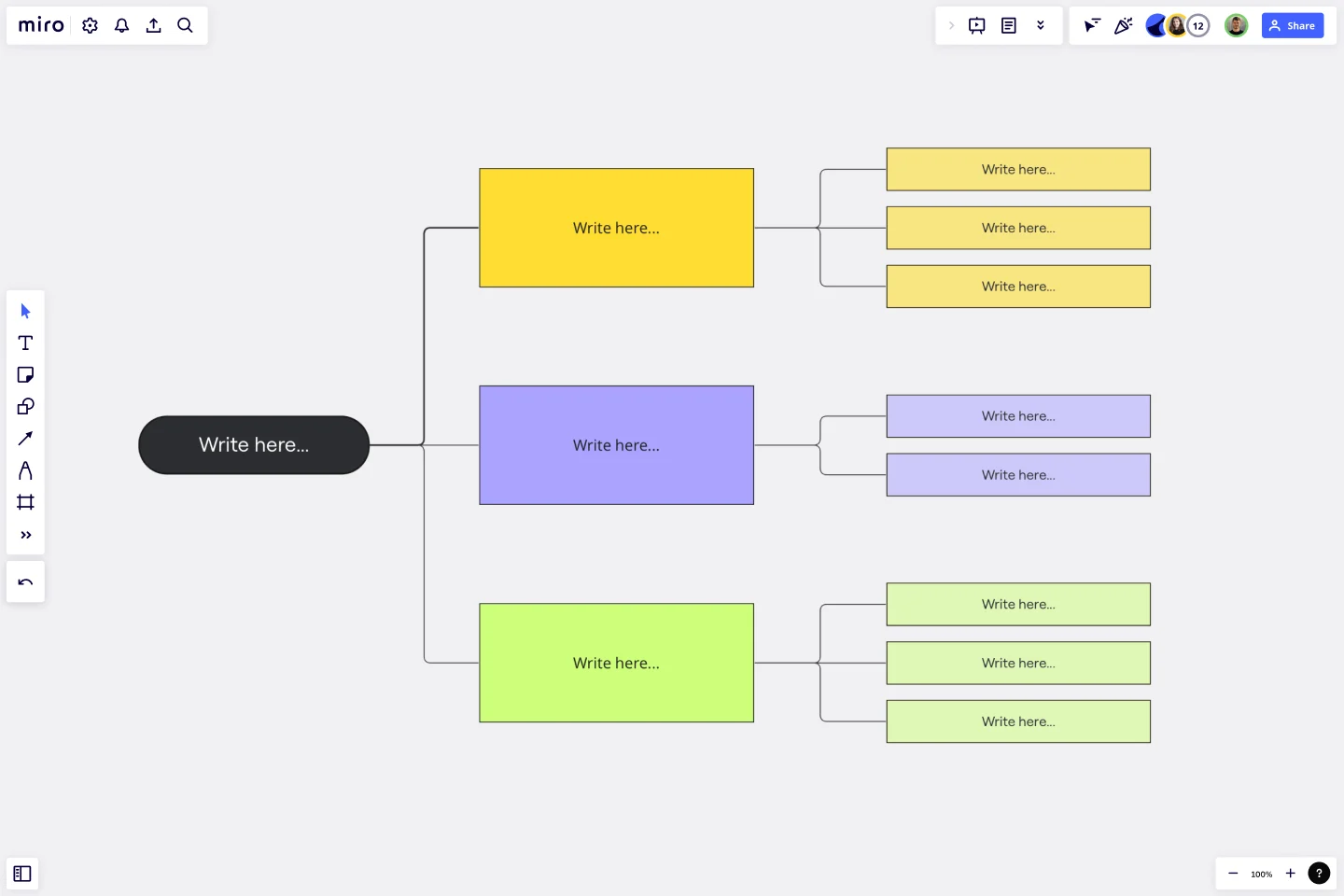Brace Map Template
Elevate your brainstorming and planning with the brace map template.
Trusted by 65M+ users and leading companies
About the Brace Map Template
The brace map template helps you organize, analyze, and visualize complex ideas in a clear and structured manner. Whether you're brainstorming, planning projects, or teaching concepts, the brace map provides an adaptable workspace for your thoughts to grow.
What's the brace map template?
The brace map template is a tool that helps users analyze complex ideas by breaking them down into smaller, more manageable components. This template consists of a central concept or idea connected to supporting sub-elements through braces, forming a hierarchical structure, like a mind map. Each "brace" represents an association or relationship between the central concept and its supporting elements.
The template is divided into several key areas that allow users to organize their thoughts, including:
Central concept: This is the core idea you want to explore or analyze.
Main brace: The primary connection extends from the central concept, symbolizing the main category or theme.
Sub-braces: These extend from the main brace, representing sub-categories or supporting details.
Text boxes: Add detailed information or descriptions to each brace, providing clarity and context.
How to use the brace map template in Miro?
Edit easily: Customize the central concept, main brace, and sub-braces by simply clicking on them. Edit text, colors, and shapes effortlessly.
Expand automatically: Easily expand your brace map with a single click, allowing you to dive deeper into sub-categories and create a comprehensive visual representation.
Add context: Enhance your map by adding artifacts like images, links, or documents directly onto the Miro board, providing additional context and depth to your visualizations.
Why should you use a brace map template?
Clarity: Organize complex ideas into a structured format for enhanced clarity.
Visual hierarchy: Clearly define relationships and hierarchies between different elements.
Efficient communication: Streamline communication by presenting information in a visually digestible format.
Collaboration: Foster collaboration by creating a shared visual space for brainstorming and planning.
Dynamic exploration: Easily adapt and expand your thoughts as ideas evolve, keeping your visualizations dynamic and relevant.
Can I customize the colors and shapes of the braces in the brace map template?
Yes, click on the desired brace or element, and a menu will appear, allowing you to customize colors, shapes, and text.
How can I quickly expand the brace map with additional sub-braces?
Click on the expand button, and the brace map will dynamically grow, revealing space for additional sub-braces.
Is it possible to collaborate in real time on a brace map in Miro?
Certainly! Share your Miro board with collaborators; everyone can contribute in real time.
Can I export the brace map for external use or sharing?
Yes, Miro allows you to export your brace map in various formats, such as PDF or image files, making it easy to share your visualizations outside the platform.
Get started with this template right now.
UML Sequence Deployment Pipeline Template
Works best for:
UML
The UML Sequence Deployment Pipeline Template in Miro visually maps the sequence of steps in an automated deployment pipeline, helping teams in software development and deployment. It helps identify bottlenecks, standardizes the deployment process, and facilitates new member onboarding for continuous improvement.
ERD Healthcare Management System Template
Works best for:
ERD
The ERD Healthcare Management System Template streamlines the process of creating and managing entity-relationship diagrams for healthcare management systems. This template helps users visualize the complex relationships between different entities such as patients, healthcare providers, medical records, and billing information. It offers a flexible and customizable framework that can be adapted to fit the specific needs of any healthcare management system, ensuring clarity and efficiency in system design and database structure.
ERD Supply Chain Management System Template
Works best for:
ERD
The ERD Supply Chain Management System Template streamlines and optimizes supply chain operations. It serves as a visual support that helps businesses understand and manage the complex relationships between different entities within their supply chain, such as suppliers, products, inventory, orders, and shipments. By providing a clear visualization of these relationships, the template enables users to identify inefficiencies and areas for improvement, facilitating strategic decision-making.
LUMINAI Refinery Advisor on AWS Template
Works best for:
AWS
The LUMINAI Refinery Advisor on AWS template streamlines and optimizes refinery operations through AWS. It provides a structured approach to setting up and managing AWS services, tailored specifically for engineers, developers, and data scientists in the refinery sector. This template not only saves time and effort by offering a predefined structure and best practices but also allows for customization to meet specific operational needs. With its focus on enhancing data processing capabilities, the LUMINAI Refinery Advisor on AWS template is an invaluable resource for improving the efficiency, effectiveness, and optimization of refinery processes on the AWS platform.
Datavant Switchboard with AWS Clean Rooms Template
Works best for:
AWS
The AWS Datavant Switchboard Clean Rooms Template integrates health data sources using Datavant's secure data connection capabilities and AWS Clean Rooms' scalable data processing environment. It's useful for professionals in engineering, database management, and development. The customizable Miro interface streamlines secure and efficient data handling and team collaboration for a wide range of projects.
Genogram Template
Works best for:
Diagramming
The Genogram Template maps out family structures and relationships with exceptional depth and detail. Unlike traditional family trees, this template provides a comprehensive perspective by encapsulating familial connections, emotional ties, and significant life events. Create a genogram to unearth patterns and trends within a family, whether hereditary or environmental. Professionals across different domains can gain a holistic understanding of familial dynamics by showing deep insights into the nuances of relationships, facilitating better communication and problem-solving.
